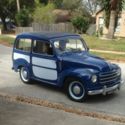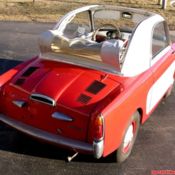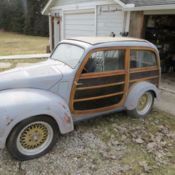1979 P.B.S. FIAT X19
- Condition: Used
- Make: Other Makes
- Model: G80
- Year: 1979
- Mileage: 16,576
- Vehicle Title: Clear
- Location: Irvine, California, United States
Description
VIN #128AS10100078
YOU ARE BIDDING ON A 1979 FIAT X19 1600CC FULL P.B.S. ENGINE CONVERTION. BORED, PORTED, POLISHED AND BLUE PRINTED. I BOUGHT THE CAR NEW AND ABOUT A YEAR OR SO LATER I GAVE P.B.S. THE GO AHEAD. WORK DONE AS FALLOWS:
TRUE MILES 16,576!!
BIG VALVE HEAD
STROKER CRANK (1600CC)
RACING CAM S1??
HEADERS
TWIN 45 DCOE WEBER CARBS WITH GROSE JETS
LIGHTENED EVERYTHING THAT COULD BE
UPGRADE PISTONS & RODS
NAS BOLTS
AEROQUIP
PUROSIL HOSE
AND MUCH MORE
TOTAL $ 8,000 + (TODAY $20,000 +)
BODY:
SILVER + CLEAR
MANY PARTS CHROMED (BLACK), POLISHED, POWDER COATED, FROM TOP TO UNDER
GOLD & CHROME GOTTI WHEELS
LOUVERED HOOD
GLASS AND METAL EMBLEMS
ABARTH REFLECTOR
INTERIORS:
ENGLISH WOOL CARPET
RECARO SEATS
BROWN LEATHER, SIDES AND REAR
PERSONAL STEERING WHEEL
ALUMINIA ANTI SKID PADS (ACC, CLUTCH & BRAKE)
V.D.O. GAUGE
SUSPENSION:
MOST, NOT ALL, RACED OUT
SWAYBARS
BRAKES:
FRONT, RABBIT GTI DRILLED
REAR, OEM DRILLED
*********Missing: Battery & 2 Spark Plug Wires************
PBS X1/9-128 RACING MODIFICATIONS
This brochure covers many of the modifications which PBS has developed for the Fiat 128 and the Fiat/Bertone X1/9.
The 128 series engines were first imported into the U. S. in 1971 as an 1100cc engine in the Fiat 128 sedan. This engine has a bore of 80mm and a stroke of 55.5mm. The single overhead cam head, with in-line valves, has all eight ports on the same side of the head. The intake valves are 36mm in diameter and the exhaust valves are 31mm in diameter. A single throat Weber carburetor and a single outlet cast iron exhaust manifold are employed on the '71-73 128 sedans.
In 1973 the 128SL coupe introduced the 1300cc version of the S.O.H.C. 128 series engine. This engine has a bore of 86mm and a stroke of 55.5mm. The crank is identical to the 1100cc crank. The cylinder head is basically the same as the 1100cc head except for having a larger combustion chamber to compensate for the larger displacement. While the bore spacing is the same on the 1100cc and 1300cc blocks, the 1100cc block cannot be bored to 86mm because the water jacket cores are different and the 1100cc cylinder walls are not thick enough to allow a 6mm bore increase.
In 1974 the X1/9 was introduced to the U. S. with the 1300cc engine. The `74 X1/9 and 128 coupes and sedans were also fitted with two throat Weber carburetors and dual outlet cast iron exhaust manifolds. Also, air injection into the exhaust port was introduced on the `74 models The distributor was changed from the Marelli unit used on the earlier engines to a Ducellier distributor with a vacuum retard device for emission control.
The 128 and X1/9 engines have minor differences. For example, the intake and exhaust manifolds are different because of the engine mounting angles being different. The motor mounts are also different. The X1/9 has a cast aluminum oil pan vs. the 128 sheet metal pan, and the oil pump pickup castings are different.
The `75 through `78 engines are basically the same as the `74 1300cc engine except for a number of minor changes. Most of these are associated with the emission control systems. When catalytic converters were added, the exhaust manifold was changed back to a single outlet design. The two throat carburetors on, these engines are fitted with water heated automatic chokes.
In about 1977 the air injector system was changed. The earlier version, employed four separate inlets into the cylinder head. The later system uses a single inlet which feeds a long drilled passage in the head. This passage extends into the water outlet area on the end of the cylinder head. It is essential to use the later thermostat housing and gasket with the late air injector style head in order to prevent water leakage into the exhaust ports. When water runs out the tail pipe on one of these engines after it has been worked on, the cause usually turns out to be the use of an early type thermostat housing gasket.
The 1979 and later X1/9s and Strada sedans are fitted with 1500cc versions of the S.O.H.C. engine. The bore of this engine is 86.4mm and the stroke is 63.9mm. The 1500cc exhaust valves are enlarged to 33mm from the 1300cc 31mm valves. The intake valves on both engines are 36mm in diameter. The 1500cc connecting rods are steel forgings rather than castings as in the 1300cc engine, but they are also longer than the 1300cc rods. The 1500cc block is taller than the l300cc block to accommodate the longer stroke crank and longer rods without changing the crown height on the pistons.
The '79 1500cc engines are fitted with a small two throat Weber carburetor which has a vacuum activated secondary throttle butterfly. The `79 cars have E.G.R. and an air pump for emission control as well as a catalytic converter. The `80 and later 1500cc engines have Bosch electronic fuel injection systems and no E.G.R. or air pump. Thus the `79 block is the only one with mounting bosses for the E.G.R. system. All of the 1500cc engines came with Bosch electronic ignition systems.
All of the 128-X1/9 engines are relatively short-stroke, large-bore (over square) engines. This allows them to run at high r.p.m. without undue stress or wear on the lower end of the engine.
Breathing is relatively restricted in these engines. The intake ports and valves are basically the same on all three sizes of the engine. The exhaust valves ore the same on the 1100cc and 1300cc engines, while the 1500cc engine has 2mm larger exhaust valves. Unfortunately, performance of these engines is quite insensitive to exhaust valve size. On the other hand, performance is definitely enhanced by enlarging the intake port and valve size. Inlet breathing (volumetric efficiency) is also restricted by the stock carburetors and intake manifolds, or fuel injection systems. The 1974 exhaust systems are the least restrictive of the stock exhausts. This system consists of a cast exhaust manifold with two outlets followed by twin, stainless steel downpipes and a muffler. The earlier and later systems all use a single downpipe. The later systems with both a catalytic converter and a muffler are quite restrictive.
PBS has conducted numerous design and development projects on the various 128-X1/9 engines with the object of enhancing performance for various racing applications. These projects have included development of 16 valve D.O.H.C. engines based on the 128 1300cc block for SCCA C sports racing, 1200cc S.O.H.C. engines for D sports racing, 1300cc and 1500cc engines for G and F production racing respectively, 1300cc S.O.H.C. engines for GT-5 racing, 1600cc engines with PBS manufactured stroker cranks for slalom racing, etc. The PBS facility includes a casting pattern shop, a complete machine shop (including crankshaft and camshaft grinders, etc.), engine assembly area, and a fully instrumented engine dyno meter. Components for the various racing engine projects are designed, manufactured, assembled and thoroughly tested in- house. Only the parts that really provide useful performance and/or reliability improvements are put into production for sale to our customers.
Our extensive involvement with SCCA racing for over 20 years has allowed us to further develop our products under actual racing conditions. PBS personnel have campaigned Fiat powered cars in Dsr, Csr, Formula C, GT-5, F production and E production. We have worked closely with customers in several other SCCA classes as well.
Initial testing on the 1300cc version of the 128-X1/9 engines indicated that while the addition of more carburetion, exhaust headers, and larger cams did provide some power increase, the end results were rather disappointing. This was particularly true with larger cams which tended to hurt the already anemic low speed torque of the short stroke engine while providing only a very marginal power improvement at high r.p.m. Analysis of the data suggested that the internal breathing of the motor was so restricted that the addition of bolt-on high performance equipment had relatively little effect.
The PBS 128-X1/9 big valve head was conceived, designed, and developed to optimize the breathing of the engine without compromising its basic reliability. Stock cylinder heads were sawed apart to determine casting wall thicknesses, etc. so the ports could be enlarged to the practical limit without danger of cracking into the water jacket. Dyno testing was done on several different configurations to determine the effects of valve size (both intake and exhaust), valve seat size and shape, and combustion chamber shape.
Testing showed that the engine was basically insensitive to exhaust valves and ports, but responded very well to increases in intake port, seat, and valve sizes. The limiting factor is the port size which can only be increased to the point where sufficient wall thickness remains to the water jacket. With the largest practical ports, valve sizes beyond 40mm diameter don't produce any further appreciable performance gains. The intake valve seats must be enlarged to be compatible with the new valves in order to gain any benefit. For applications, such as production class racing, which don't allow valve diameter increases, the ports can still be enlarged. The valve seats can also be enlarged to the point where the valves contact very close to the outer periphery of the valve head. This allows the flow to be optimized within the rules of the racing class. Running the valve contact out to the edge does require frequent replacement of the valves, however. Note that the valve seats must be enlarged on both the inside and outside diameters. Just boring out the stock seats causes them to be weakened to the point where they will frequently fall out of the head after numerous temperature cycles. We have run dyno tests on customers engines which were fitted with big valve heads made in Europe. Some of these had up to 42mm intake valves and larger than stock exhaust valves as well.
No performance benefit was noted for these heads compared with the PBS big valve head. However, in order to accommodate the enlarged exhaust valves, the new valve seats actually overlapped. That is, the intake seat was installed first and the head was bored for the exhaust seat to the point where the cutter actually cut partially into the intake valve seat. This creates a rather weak and uneven support for the two valve seats. The end result is that the seats don't stay accurately positioned in the head after repeated temperature cycling in operation. Thus the valve seal deteriorates after a few hours of operation and the valve seats must be frequently reground.
Once a big valve head has been installed on the 128-X1/9 engine, the performance will respond nicely to increased carburetion, headers, modified cams, etc. However, selection of the proper camshaft is still critical. As with any engine, performance gains at high r.p.m. must be weighed against the performance loss at low to moderate engine speeds. This is more critical with the shorter stroke 1100cc and 1300cc engines than with the 1500cc and longer stroke engines.
After development of the upper end of the l300cc engines, it became obvious that additional torque and power could best be obtained by increasing the stroke of the crankshaft of course, Fiat had this in mind also when it produced the 1500cc engines starting in '79. In the meantime, PBS designed and started production on a 1600cc crankshaft with a 68mm stroke. The PBS stroker crank is a ductile iron casting using material similar to the stock crank. It employs twice as many counterweights as the stock crank, however. This makes the casting process considerably more difficult but the end product is a smoother running engine with reduced main bearing loads. The stroker crank makes a tremendous improvement in low and mid-r 1970 Fiat 850 Van
1970 Fiat 850 Van
Mileage: 37,207
 Lada VAZ 2101 (fiat 124)
Lada VAZ 2101 (fiat 124)
Mileage: 4,000
 fiat 500L 1972 vintage
fiat 500L 1972 vintage
Mileage: 100,000
 1972 Fiat Seat 600 Savio Jungla - Mini Jeep
1972 Fiat Seat 600 Savio Jungla - Mini Jeep
Mileage: 61,000
 SIATA SPRING 1968 FIAT 850 BASED CONVERTIBLE *RARE*
SIATA SPRING 1968 FIAT 850 BASED CONVERTIBLE *RARE*
Mileage: 41,709
 1953 FIAT BELVEDERE - VINTAGE AUTOMOBILE - RESTORED TOPOLINO
1953 FIAT BELVEDERE - VINTAGE AUTOMOBILE - RESTORED TOPOLINO
Mileage: 40,000
 1959 59 Autobianchi Bianchina Trasformabile Micro Car FIAT Microcar Survivor
1959 59 Autobianchi Bianchina Trasformabile Micro Car FIAT Microcar Survivor
Mileage: 43,461
 1948 FIAT 3 DOOR WOODY WAGON,HOT-RAT ROD,GASSER,4.3 V-6,9" FORD,MUSTANG FRONT,NR
1948 FIAT 3 DOOR WOODY WAGON,HOT-RAT ROD,GASSER,4.3 V-6,9" FORD,MUSTANG FRONT,NR
Mileage: 100,000
 1970 Fiat 500 Abarth 695 ss Gruppo 5 Race Street Car Project Classic Muscle
1970 Fiat 500 Abarth 695 ss Gruppo 5 Race Street Car Project Classic Muscle
Mileage: 23,359
 1975 FIAT- AUTOBIANCHI A112 ABARTH RE-CREATION, MINT CONDITION, RUST-FREE
1975 FIAT- AUTOBIANCHI A112 ABARTH RE-CREATION, MINT CONDITION, RUST-FREE
Mileage: 82,699











